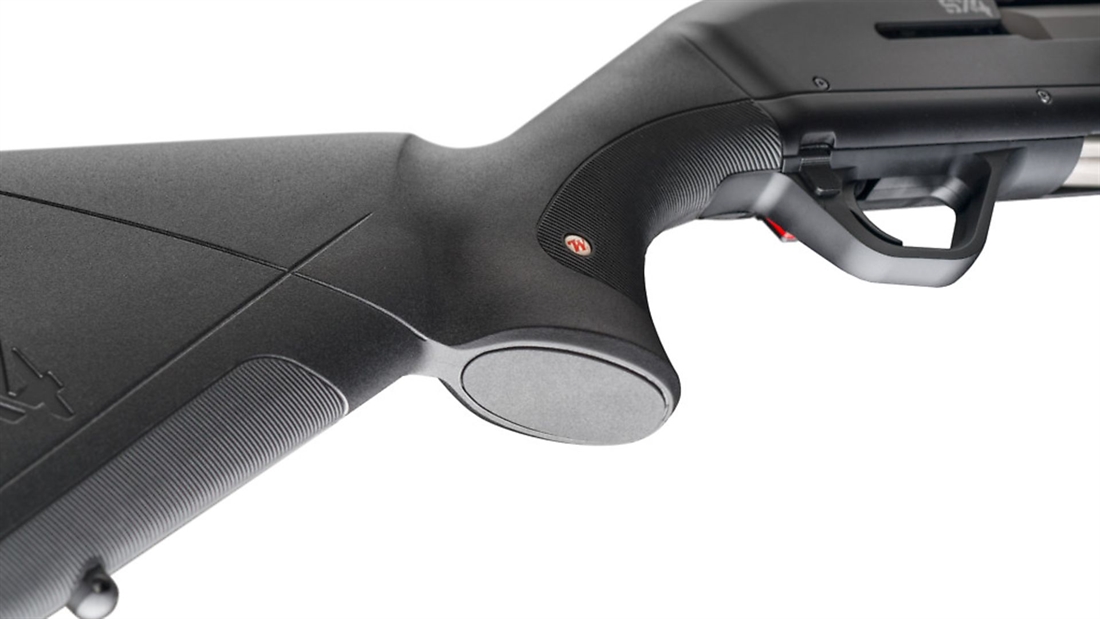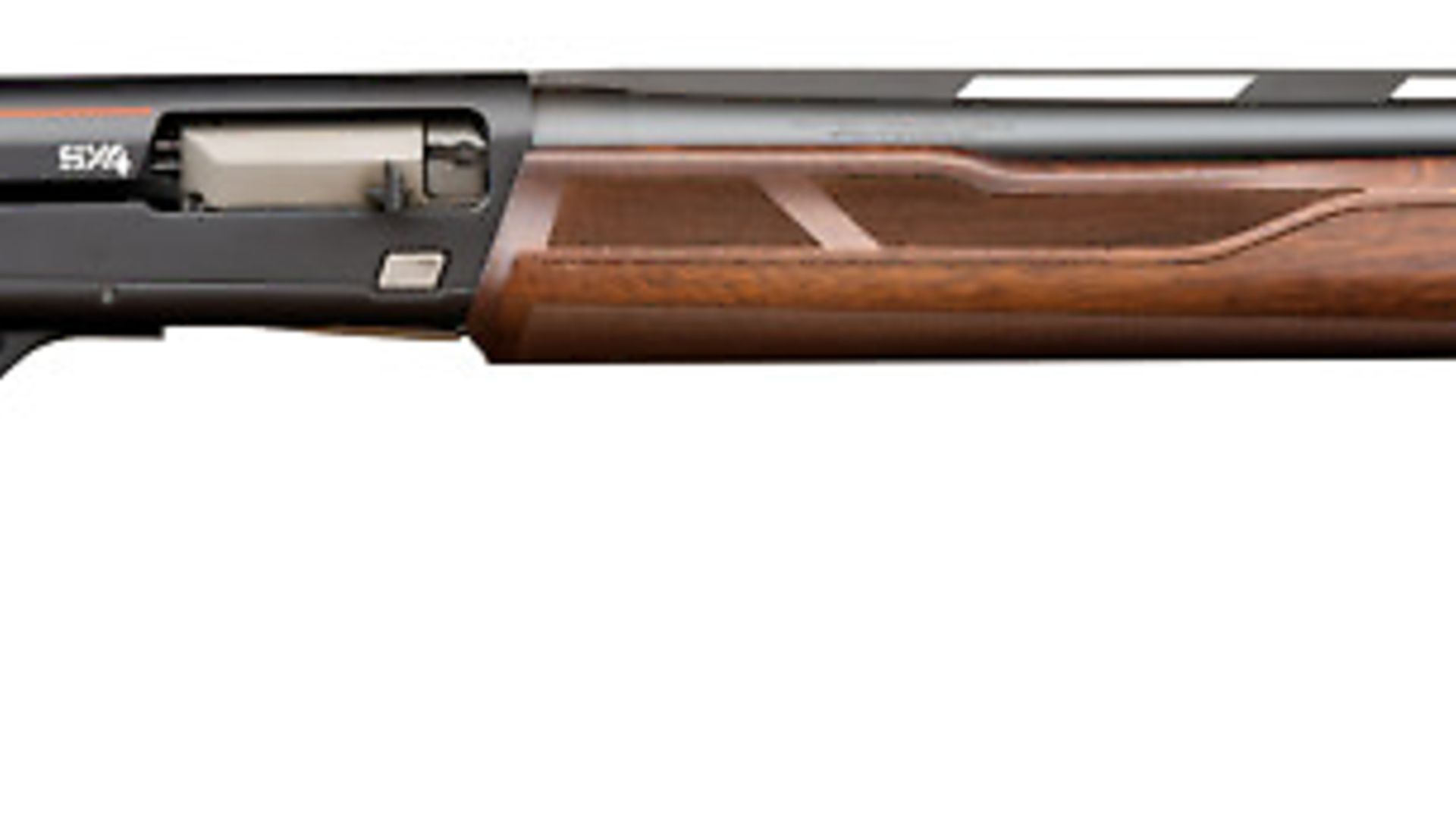Gun test – Winchester SX4

Mike Yardley test this fun, affordable, three-shot semi-auto shotgun from Winchester… perfect for pigeon shooting or wildfowling forays across the marshes
Make: Winchester
Model: SX4
Chamber: 3 1/2
Barrel: 30” (26 and 28” options)
Rib: Raised 6mm
Choke: Investor Plus
Weight: approx 7lbs.
RRP: £715
We Like…
The great value
The smart design
The high standard of finish
We don’t like…
The heavy trigger pull
The low comb and lack of means for stock adjustment
Technical…
The 3½” model Winchester, like the Browning before it, must be considered quite a triumph of engineering as it can digest 2¾, 3 and 3½” shells interchangeably. This generation of guns all cycle extremely quickly, partly because the mass of their reciprocating parts is much reduced. As on the Browning Maxus, gas ports have been made larger to handle anything from 24-64g payloads (the only thing I would not recommend from experience is a 24g 2½” load, but a 24g 2¾” [70mm] should work fine). The ‘integrated valve’ system is designed to keep muck out of the action, and the stroke length – one of the keys to rapid cycling – has been modified to improve function with the lighter payload cartridges, which are now popular. There is also an improved trigger mechanism, though in the test gun the pulls were quite heavy (forcing me to resort to the first joint of my trigger finger in live firing).
Shooting Impressions…
I shot the gun with Chris Bird of Holland & Holland at their wonderfully appointed shooting ground near Uxbridge. It is being expanded at the moment with a state of the art underground cinematic rifle range and improved entertainment and conference facilities. I have been using it for many years and it sets the standard for professional shotgun and rifle instruction in the UK. With that well-deserved plug given, I will note that Chris and I were genuinely impressed with the SX4, especially at the price point. It shot very well indeed. I especially liked the relatively light weight for length of barrel, however the trigger pull was heavy and the recoil was a little more than expected from a gas gun with a wider than average bore. Using Lyalvale HV 28g loads there were no malfunctions at all. At the price, there is very little to compare the SX4 with. It is well-designed, well-made (in Portugal) and well-finished. It may not have any bells and whistles, but do you need them on the marsh, bashing bunnies in a field, or shooting woodies from a hide? I think not. Overall, an excellent gun for the money.
A little more detail…
we are looking at the latest thing from Winchester: the well-priced SX4 Composite semi-auto (RRP £715). It is a 30”, 3½” chambered steel-proofed gun with Invector Plus chokes (three supplied). First impressions are very good, considering the price point. The smart, black anodised action and streamlined stock and fore-end ticked my boxes. Aesthetically, you could not ask for more for the money; the plain decoration and smart form are just the ticket for a modern working gun.
The test SX4 was a three-shot model (permissible on a normal shotgun certficate), but there is a five-shot option if you have the relevant permissions, not to mention a wooden-stocked Field model with a 3” chamber (RRP £725), and a 3½” Mossy Oak Break-up Country camo gun for £771. Frankly, the test-gun style would be my option for just about all applications: nothing too fancy, but quite smart nevertheless. The SX4 replaces the older and excellent SX3. I had the Red Performance version of the latter, which was always guaranteed to start a conversation on the layouts! Some may also remember the Flanigan, or ‘Flani-gun’, extended mag SX3 with which Patrick Flanigan broke various speed shooting records.
Essentially, the SX4 is a slightly simplified SX3. The gun is supplied in a cardboard box, rather than an ABS case, to keep down cost. Mechanically, there is very little difference between the two. The action is almost the same as the SX3, but sadly there is no shim kit for stock adjustments, and there are some other small changes. The cocking handle of the new gun is significantly bigger, a positive change over the older model, and the bolt release is bigger, and better, too. Stock shapes have been improved and there is a new 25mm Inflex recoil pad.
While considering the history and evolution, we might go back just a little further. I can remember being invited to the US when Browning launched the Gold Hunter more than a decade back (it was later called the Fusion). The Gold/Fusion was the design from which the SXs evolved, and were notable for some very clever innovations, in particular a variable venting gas piston and new sort of cocking sleeve made from glass-fibre-reinforced nylon. It resulted in a very rapid cycling action and one which was not as cartridge-sensitive as some. The Golds, which were seen in 3 and 3½” guises had a speed-loading feature and a magazine cut-off. These are not generally features of the SX (although the 20-bore model Super X 3 does have a mag cut-off, just to be different).
The SXs, like their old Browning cousins (if you want the Browning version now you can only get a 10-bore, and we must try one!), have a short, quick piston stroke, employing a piston rod rather than a conventional slide arm. This simplifies production and also aids functioning with lighter loads – often a problem with semi-automatics. The gas valve is on the inside of the gas piston (so there is no need for a sprung valve in front of the barrel gas ring, as seen on most other recent designs). The guns can use a wide variety of cartridges without adjustment.
Moving on to the synthetic stock of the test gun, it has a length of pull of just under 14½” – good for Mr Average if heavy clothing is being worn, as it may well be a tool with which you venture onto the marsh. The stock has quite a lot of drop – a little too much – with a heel dimension of nearly 2½” and a front-of-comb measurement of 2” relative to the rib axis. The grip is not too big and is pleasantly shaped; for my hand it could have been a fraction bigger, especially to the underside. The fore-end was nicely shaped and not too thick. I thought the fore-end nut more attractive than some, too.






